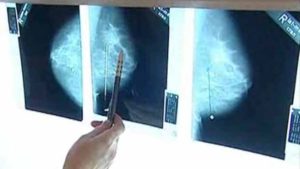 H. Gilbert Welch has written extensively about the issue of "overdiagnosis" and resulting "overtreatment" of cancers. Cancer screening can cause the problem of overdiagnosis (finding small tumors that may never cause problems) and lead to overtreatment (treating unnecessarily, which can cause harm).
H. Gilbert Welch has written extensively about the issue of "overdiagnosis" and resulting "overtreatment" of cancers. Cancer screening can cause the problem of overdiagnosis (finding small tumors that may never cause problems) and lead to overtreatment (treating unnecessarily, which can cause harm).
But now Welch and coauthor Otis Brawley discuss the issue of how too much screening and diagnostic testing of people thought to be "high risk" for certain cancers results in more being found - thus the risk factors are "self-fulfilling". And it occurs the most in "scrutiny dependent cancers" - which are cancers that the more you look, the more you find, and the more of what you find is harmless. Many are referred to as slow-growing, indolent, subclinical, or even as precancerous. Prostate cancer, thyroid cancer, breast cancer, melanoma, and lung cancer are examples of "scrutiny-dependent" cancers.
Looking so hard and then finding cancer gives a false impression of an increased incidence of some cancers. The authors also said that risk factors in determining who should be screened should not be cancer diagnosis (e.g. in a family member), but death from cancer. From STAT News:
Too much screening has misled us about real cancer risk factors, experts say
The best-known downside of cancer screening, such as PSA tests for prostate cancer and mammograms for breast cancer, is that they often flag cancers that pose no risk, leading to overdiagnosis and unnecessary, even harmful, treatment. But widespread screening for “scrutiny-dependent” cancers — those for which the harder you look the more you find, and the more of what you find is harmless — causes another problem, two leading cancer experts argue in a paper published on Monday: increasing the apparent incidence of some cancers. That in turn is misleading doctors and the public about what increases people’s risk of developing cancers — or at least the types of cancer that matter.
“Detecting cancers that would never become apparent is screwing up our understanding of risk factors,” said Dr. H. Gilbert Welch of the Dartmouth Institute for Health Policy and Clinical Practice, co-author of the analysis in Annals of Internal Medicine. The problem is especially clear in prostate, breast, and thyroid cancers, all of which are scrutiny dependent.
Men whose relatives developed prostate cancer are more likely to get PSA and other screening tests, either because they request them or because their physicians, noting their family histories, order them. Men with no such family history are less likely to be screened. .... (More than half of such cancers are so slow-growing that they don’t affect health or longevity.) Men who don’t get screened are less likely to have biopsies and so are less likely to be diagnosed with prostate cancer — not because they develop the disease at a lower rate but because they get screened at a lower rate. What you don’t look for, you don’t find.
“If we biopsied men without a family history of prostate cancer at the same rate that we biopsy men with a family history, we’d find more prostate cancer in them as well,” Welch said. “Family history influences how hard we look for prostate cancer and therefore how much we find. The risk factor becomes a self-fulfilling prophecy.”
A 2016 study of increased prostate cancer screening in men with a family history of the disease concluded that the risk due to family history has been overestimated by nearly half. “The risk factor of family history is spuriously strengthened because men with a family history are exposed to greater scrutiny,” write Welch and Dr. Otis Brawley, chief medical officer of the American Cancer Society, in the Annals report.
Wealthier, better educated women are, however, more connected to the health care system and therefore get more mammograms, breast ultrasounds, and MRIs. The more scrutiny, the more likely that harmless cases of breast cancer are found. (The idea of “harmless” breast cancer sounds like an oxymoron, but an estimated one-half of breast cancers detected by screening would never cause problems even if undetected and untreated.)
Breast tumors found by imaging are much more likely to be harmless than those discovered by women or their physicians finding a breast lump. Income and education are therefore less likely to be a true risk factor for breast cancer and more likely to be a “risk factor” for undergoing screening. If poorer, less educated women were screened for breast cancer at the same rate as wealthier, better educated women, the socioeconomic risk factor would likely vanish.
Thyroid cancers are also scrutiny dependent, which is why when countries launch screening programs the incidence of the disease skyrockets (but death rates don’t, showing that what’s being found is a false epidemic).
Welch and Brawley call for less focus on risk factors for developing cancers, since those numbers both determine and reflect who gets screened, and more on risk factors for death from cancer.
